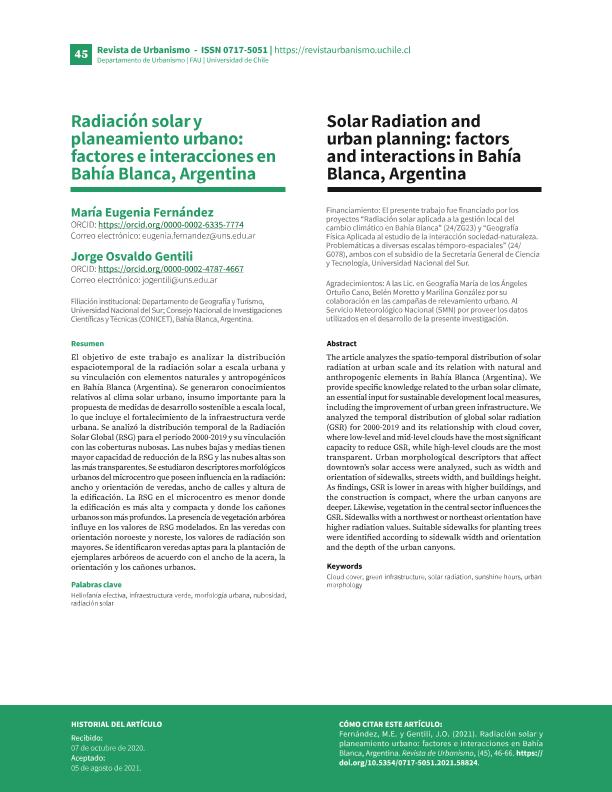Mostrar el registro sencillo del ítem
dc.contributor.author
Fernández, María Eugenia

dc.contributor.author
Gentili, Jorge Osvaldo

dc.date.available
2022-01-27T15:06:59Z
dc.date.issued
2021-12
dc.identifier.citation
Fernández, María Eugenia; Gentili, Jorge Osvaldo; Radiación solar y planeamiento urbano: factores e interacciones en Bahía Blanca, Argentina; Universidad de Chile. Facultad de Arquitectura y Urbanismo. Departamento de Urbanismo; Revista de Urbanismo; 45; 2; 12-2021; 46-66
dc.identifier.uri
http://hdl.handle.net/11336/150827
dc.description.abstract
El objetivo de este trabajo es analizar la distribución espaciotemporal de la radiación solar a escala urbana y su vinculación con elementos naturales y antropogénicos en Bahía Blanca (Argentina). Se generaron conocimientos relativos al clima solar urbano, insumo importante para la propuesta de medidas de desarrollo sostenible a escala local, lo que incluye el fortalecimiento de la infraestructura verde urbana. Se analizó la distribución temporal de la Radiación Solar Global (RSG) para el período 2000-2019 y su vinculación con las coberturas nubosas. Las nubes bajas y medias tienen mayor capacidad de reducción de la RSG y las nubes altas son las más transparentes. Se estudiaron descriptores morfológicos urbanos del microcentro que poseen influencia en la radiación: ancho y orientación de veredas, ancho de calles y altura de la edificación. La RSG en el microcentro es menor donde la edificación es más alta y compacta y donde los cañones urbanos son más profundos. La presencia de vegetación arbórea influye en los valores de RSG modelados. En las veredas con orientación noroeste y noreste, los valores de radiación son mayores. Se identificaron veredas aptas para la plantación de ejemplares arbóreos de acuerdo con el ancho de la acera, la orientación y los cañones urbanos.
dc.description.abstract
The article analyzes the spatio-temporal distribution of solar radiation at urban scale and its relation with natural and anthropogenic elements in Bahía Blanca (Argentina). We provide specific knowledge related to the urban solar climate, an essential input for sustainable development local measures, including the improvement of urban green infrastructure. We analyzed the temporal distribution of global solar radiation (GSR) for 2000-2019 and its relationship with cloud cover, where low-level and mid-level clouds have the most significant capacity to reduce GSR, while high-level clouds are the most transparent. Urban morphological descriptors that affect downtown's solar access were analyzed, such as width and orientation of sidewalks, streets width, and buildings height. As findings, GSR is lower in areas with higher buildings, and the construction is compact, where the urban canyons are deeper. Likewise, vegetation in the central sector influences the GSR. Sidewalks with a northwest or northeast orientation have higher radiation values. Suitable sidewalks for planting trees were identified according to sidewalk width and orientation and the depth of the urban canyons.
dc.format
application/pdf
dc.language.iso
spa
dc.publisher
Universidad de Chile. Facultad de Arquitectura y Urbanismo. Departamento de Urbanismo
dc.rights
info:eu-repo/semantics/openAccess
dc.rights.uri
https://creativecommons.org/licenses/by-nc-sa/2.5/ar/
dc.subject
HELIOFANÍA EFECTIVA
dc.subject
INFRAESTRUCTURA VERDE
dc.subject
MORFOLOGÍA URBANA
dc.subject
NUBOSIDAD
dc.subject
RADIACIÓN SOLAR
dc.subject.classification
Geografía Física

dc.subject.classification
Ciencias de la Tierra y relacionadas con el Medio Ambiente

dc.subject.classification
CIENCIAS NATURALES Y EXACTAS

dc.title
Radiación solar y planeamiento urbano: factores e interacciones en Bahía Blanca, Argentina
dc.title
Solar Radiation and urban planning: factors and interactions in Bahía Blanca, Argentina
dc.type
info:eu-repo/semantics/article
dc.type
info:ar-repo/semantics/artículo
dc.type
info:eu-repo/semantics/publishedVersion
dc.date.updated
2022-01-25T14:33:39Z
dc.identifier.eissn
0717-5051
dc.journal.volume
45
dc.journal.number
2
dc.journal.pagination
46-66
dc.journal.pais
Chile

dc.journal.ciudad
Santiago de Chile
dc.description.fil
Fil: Fernández, María Eugenia. Consejo Nacional de Investigaciones Científicas y Técnicas. Centro Científico Tecnológico Conicet - Bahía Blanca; Argentina. Universidad Nacional del Sur. Departamento de Geografía y Turismo; Argentina
dc.description.fil
Fil: Gentili, Jorge Osvaldo. Consejo Nacional de Investigaciones Científicas y Técnicas. Centro Científico Tecnológico Conicet - Bahía Blanca; Argentina. Universidad Nacional del Sur. Departamento de Geografía y Turismo; Argentina
dc.journal.title
Revista de Urbanismo
dc.relation.alternativeid
info:eu-repo/semantics/altIdentifier/url/https://revistaurbanismo.uchile.cl/index.php/RU/article/view/58824
dc.relation.alternativeid
info:eu-repo/semantics/altIdentifier/doi/http://dx.doi.org/10.5354/0717-5051.2021.58824
Archivos asociados
